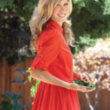That's why we don't eat animals : a book about vegans, vegetarians, and all living things
(Book)
J 641.5636 ROTH
1 available
Copies
| Location | Call Number | Status |
|---|---|---|
| Columbia Pike - Kids Nonfiction | J 641.5636 ROTH | Available |
Description
More Details
Notes
Similar Titles From NoveList
Similar Authors From NoveList
Published Reviews
Booklist Review
Some may consider this an attempt to indoctrinate the young, but in truth it's a courageous stab at a serious topic inherently hinted at through the anthropomorphizing of animals so prevalent in children's books. By contrasting animal behavior in the wild with that of their counterparts in farms or factories, Roth makes a stark case that by harvesting sentient beings we are stripping them of their rights and natural desires. For example, wild turkeys fly to the treetops to roost for the night, but factory-farm turkeys are simply fattened until their wings become useless. Roth uses her own illustrations rather than photos, but she wisely does not make her animals too cute. Be warned: her depictions of poultry confined within filthy cages, while abstract, are fairly disturbing. Inevitably this will book incense those on the other side of the issue but there is much to be learned here (about animal behavior if nothing else). A unique effort that is to be applauded.--Kraus, Daniel Copyright 2009 Booklist
Publisher's Weekly Review
Declaring that "All animals deserve the care and protection we give our pets," newcomer Roth takes the vegetarian/vegan cause to young readers. Highly stylized illustrations against white backdrops depict angular caricatures of farm animals with oversize nostrils, as a single-sided narrative compares the existence of several feathered and furred livestock with their counterparts in nature ("A factory-farmed pig may spend her whole life alone, fattened in a pen so tiny that she won't even be able to turn around.... Pigs need the sight, sound, and touch of one another.... Love is part of their nature." Later spreads present barren landscapes in dark hues as the author touches on commercial overfishing and rain forest exploitation. Children may find the heart-tugging descriptions and images (such as the all-gray scene of jungle animals stranded in a charred wasteland or sad chickens "crammed into cages on factory farms") a little overwhelming. Concluding with a list of tips for action around vegetarian/vegan ideals, this book-despite its lack of counterpoint or source material-is sure to raise awareness and questions. Ages 6-10. (May) (c) Copyright PWxyz, LLC. All rights reserved
Kirkus Book Review
From an opening that establishes all earthlings' mutual connection, Roth follows with evidence of humanlike behavior among animals. Turkeys dance and grieve together; they blush and fly to the treetops when the moon comes out. In factory farms they have no freedom and are made too fat to fly. Fish, cattle, ducks, geese, chickens and pheasants are all similarly mistreated. Carnivorous diets for humans are destroying the rainforests and killing endangered species. This tract spends most of its time supporting the idea that animals are very like people and too cute to eat. The unsubtle illustrations feature black-beadeyed animals that are adorable in the wild but terrified and dirty on the farms. Environmental impact gets a mention, but health concerns (for humans) get no ink at all. Also, the suggestion that pets can survive on a vegetarian diet can kill those that are carnivores in the wild. Children young enough for this are in no position to make dietary choices for themselves; it will work best for children in already vegan or vegetarian households. (Informational picture book. 6-10) Copyright Kirkus Reviews, used with permission.
Booklist Reviews
Some may consider this an attempt to indoctrinate the young, but in truth it's a courageous stab at a serious topic inherently hinted at through the anthropomorphizing of animals so prevalent in children's books. By contrasting animal behavior in the wild with that of their counterparts in farms or factories, Roth makes a stark case that by harvesting sentient beings we are stripping them of their rights and natural desires. For example, wild turkeys "fly to the treetops to roost for the night," but factory-farm turkeys are simply fattened until their wings become useless. Roth uses her own illustrations rather than photos, but she wisely does not make her animals too cute. Be warned: her depictions of poultry confined within filthy cages, while abstract, are fairly disturbing. Inevitably this will book incense those on the other side of the issue but there is much to be learned here (about animal behavior if nothing else). A unique effort that is to be applauded. Copyright 2009 Booklist Reviews.
Publishers Weekly Reviews
Declaring that "All animals deserve the care and protection we give our pets," newcomer Roth takes the vegetarian/vegan cause to young readers. Highly stylized illustrations against white backdrops depict angular caricatures of farm animals with oversize nostrils, as a single-sided narrative compares the existence of several feathered and furred livestock with their counterparts in nature ("A factory-farmed pig may spend her whole life alone, fattened in a pen so tiny that she won't even be able to turn around.... Pigs need the sight, sound, and touch of one another.... Love is part of their nature." Later spreads present barren landscapes in dark hues as the author touches on commercial overfishing and rain forest exploitation. Children may find the heart-tugging descriptions and images (such as the all-gray scene of jungle animals stranded in a charred wasteland or sad chickens "crammed into cages on factory farms") a little overwhelming. Concluding with a list of tips for action around vegetarian/vegan ideals, this book—despite its lack of counterpoint or source material—is sure to raise awareness and questions. Ages 6–10. (May)
[Page 57]. Copyright 2009 Reed Business Information.Reviews from GoodReads
Citations
Roth, R. (2009). That's why we don't eat animals: a book about vegans, vegetarians, and all living things . North Atlantic Books.
Chicago / Turabian - Author Date Citation, 17th Edition (style guide)Roth, Ruby. 2009. That's Why We Don't Eat Animals: A Book About Vegans, Vegetarians, and All Living Things. Berkeley, Calif.: North Atlantic Books.
Chicago / Turabian - Humanities (Notes and Bibliography) Citation, 17th Edition (style guide)Roth, Ruby. That's Why We Don't Eat Animals: A Book About Vegans, Vegetarians, and All Living Things Berkeley, Calif.: North Atlantic Books, 2009.
Harvard Citation (style guide)Roth, R. (2009). That's why we don't eat animals: a book about vegans, vegetarians, and all living things. Berkeley, Calif.: North Atlantic Books.
MLA Citation, 9th Edition (style guide)Roth, Ruby. That's Why We Don't Eat Animals: A Book About Vegans, Vegetarians, and All Living Things North Atlantic Books, 2009.































